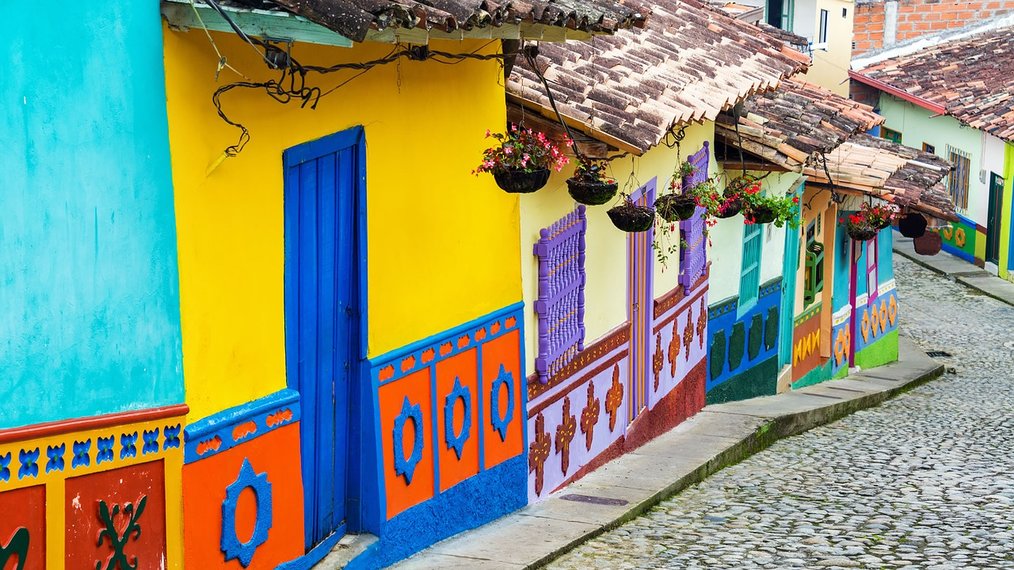The 7 Best Places to Learn Spanish Abroad
With the many Spanish-speaking countries worldwide, the decision of where to seek a language immersion experience is a difficult one. We have broken down 7 popular categories to help you choose the best destination to learn Spanish abroad.

You’ve tried your best at following Mexico’s finest telenovelas with the subtitles on and have taken to watching Sesame Street for a chance to count along -- uno, dos, tres! -- with Elmo and Grover. But if you don't seem to be learning Spanish fast enough for your liking, then it’s time to bite the bullet and accept that you might need to go a step further: invest in language tuition in a Spanish-speaking country abroad.
As the first language of 20 countries and nearly 500 million people worldwide, Spanish has the world’s second-highest number of native speakers and is becoming increasingly important in many job markets. For the travel-minded, speaking Spanish opens up a whole new world of friends and deeper connections with those you meet as you trot across the globe!
Language Immersion is universally accepted as the best way to learn a new language, so your top strategy is to pick a Spanish language school abroad for studying Spanish. Luckily for you, there are hundreds of options out there for eager future Spanish speakers, even if you’re starting with a base of nothing more than “hola” and “gracias.”
So where’s the best place to learn Spanish abroad, you ask? Unfortunately, there is no one-size-fits-all when it comes to learning Spanish, considering the major linguistic, cultural, and even economic differences between countries. Luckily, this means that you’re guaranteed to find one that you think is entirely perfecto for you.
To help you come to this conclusion, we've listed out the best places to learn Spanish abroad broken down into categories to best fit your goals:
- For Mastering the Basics: Columbia
- For The Budget-Conscious: Guatemala
- For A Cosmopolitan Experience: Argentina
- For a Nature Packed Experience: Costa Rica
- For Future-Proofing your Spanish: Spain
- For History Buffs: Peru
- For Mastering Culinary Vocabulary: Mexico
For Mastering the Basics: Colombia

- Pros: With the locals speaking Spanish with barely a waft of an accent, it’s a great place for beginners to get their ears in.
- Cons: Spanish tuition in Colombia can be more expensive than comparative classes in other parts of Latin America.
Rolos (residents of the capital city of Bogotá) are quick to inform travelers that they speak the best Spanish in all of Latin America. While this title is up for debate (coastal Colombians, for one, probably wouldn’t agree), it’s true that Spanish speakers in central Colombia have a minimal accent and talk relatively slowly, making their Spanish among the continent’s clearest and easiest to understand.
Local folks have finally gotten wise to the considerable language advantage they have to offer, and Spanish schools are popping up in the major cities faster than you can say “arepa con queso.” The government has even sponsored an initiative to market Spanish language schools as part of the country’s new branding campaign.
Though there are benefits to all of Colombia’s cities, if you’re just here for the verbs, you’ll probably be better off sticking with either sprawling Bogotá or cosmopolitan, progressive Medellín, as the accent on the Caribbean coast can be challenging for newbies. At the same time, the humidity can also be an unpleasant distraction from lessons.
You’ll also find the former two cities make an ideal base for weekend breaks away from the classroom out to coffee fincas, volcano scattered national parks, and impenetrable jungle filled with astonishing wildlife. These are just a handful of the sparkling gems that you can find throughout Colombia.
Inspiring Language Schools in Colombia:
For The Budget-Conscious: Guatemala

- Pros: The low cost of living makes it an attractive destination for budget-minded Spanish learners.
- Cons: Rainy season, which lasts from May through October, can take some serious adjusting to.
Stunning Guatemala is an often-overlooked treasure of Central America, with most visitors passing through on a backpacking trip and relatively few choosing to stay. Despite its small size, the country has plenty to offer in terms of culture, outdoor adventures, and surprisingly affordable Spanish language classes.
The lovely colonial city of Antigua, with its veritable feast of ruined churches and dynamic nightlife, is a particularly popular spot for estudiantes. Though it runs a little on the touristy side, there’s a vast range of good-quality Spanish schools catering to visitors, while its transport links mean you’re never short of a trip to take during your time off.
Beyond its rich Mayan heritage and pleasant year-round climate (give or take a few months of rainy season), the cost of living in Guatemala is perhaps the country’s biggest draw. Even if you opt to stay in Antigua, the country’s most expensive city, the price of lessons, accommodation, and social activities remain a fraction of what you’d end up spending in a major South American metropolis like Buenos Aires or Santiago.
Inspiring Language Schools in Guatemala:
For A Cosmopolitan Experience: Argentina

- Pros: The Argentinean capital is known around the globe for its sparkling, cosmopolitan culture.
- Cons: The accent and frequent use of slang can leave beginners scratching their heads and Argentina’s long-standing financial difficulties can make studying here astoundingly cheap, or painfully expensive, depending on the current situation.
Everyone else on the continent will tell you that Argentina (or maybe Chile, depending on who you ask) is actually the worst place to learn Spanish. They may have a point – the porteño (Buenos Aires) accent is exceptionally distinctive, verb conjugations are different, and locals use all kinds of slang that is beyond baffling.
However, Buenos Aires’ popularity among expats, study abroad students and volunteers has made it a top destination for travelers, many of whom arrive in need of a little help with their Spanish. Buenos Aires has one of the highest numbers of Spanish schools in Latin America –- not to mention plenty of high-ranked universities that are open to international students.
However, the capital can wind up being an expensive place to study, particularly due to the economic crisis that has gripped Argentina in the past few years and the fact that cash can be quite hard to get hold of. Financial uncertainty can be mitigated with proper research and by reading up on the essential things to know before you go there to study abroad.
The same is true of the smaller university city of Córdoba, which offers equal academic quality without the hectic feeling of the capital, plus some rather beautiful surroundings, thanks to its picturesque architecture.
Though it’s certainly different, the Spanish spoken in Argentina has a distinct style that differentiates it from other countries. By studying and using the Argentine brand of Spanish, you’re guaranteed a warm, friendly welcome from the locals. This comes down to the fact that they belong to a nation that’s intensely proud of its own culture and identity and will give you the unique experience of learning a language that’s totally specific to where you are.
Inspiring Language Schools in Argentina:
For a Nature Packed Experience: Costa Rica

- Pros: Few countries around the globe can compete with Costa Rica when it comes to observing unique wildlife in its natural habitat.
- Cons: With such a wealth of activities, you might struggle to find time for actual study!
You may arrive in Costa Rica to learn, but when you’re not reviewing the past perfect or practicing rolling your Rs, rest assured, you certainly won’t find yourself bored.
With hundreds of miles of beaches on both coasts, zip lines strung through misty cloud forests, and some of the world’s most impressive biodiversity, Costa Rica has so many extracurricular offerings that you might well struggle to make it to class on time.
Costa Rica’s largest city is the capital of San José, but even the locals will tell you to skip town as fast as possible and head somewhere a little more scenic -- as in, pretty much anywhere else in the country. Luckily, wherever you go, the laid-back ticos and ticas of Costa Rica speak at a pace that won’t be too intimidating for newbies.
Costa Rica’s booming tourism industry means services are catering to travelers almost everywhere, so it shouldn’t be hard to find a city, town, or stretch of jungle for signing up to a few language classes.
Take a look at surfing town Jacó, the northwest beach region of Guanacaste, or the northern cloud forest of Monteverde as you throw yourself into the most essential part of language learning: putting your hard-earned new skills into practice.
Inspiring Language Schools in Costa Rica:
For Future-Proofing your Spanish: Spain

- Pros: Learning Spanish in Spain can put you in good stead for understanding Spanish in most other Spanish-speaking countries.
- Cons: Spanish in Spain is considerably faster and more complicated to pick up than the Spanish spoken in most countries in Latin America.
If you’re serious about learning Spanish, where better to do it than the birthplace of the language? Español de España is a whole different creature from the form spoken by all the folks on the other side of the pond. If you ever learned the entire “vosotros” conjugation, only to be told that you’d never really need it, well, it’s time to bust it out again.
Spanish has evolved and changed much more in Latin America, so the version spoken in many parts of Spain is the most traditional -- and most complex -- form of the language. Although this can present a greater challenge for those hoping to go beyond mastering the basics if you want to understand both European and Latin American Spanish, getting your head around Spanish in Spain is the most fool-proof means to achieve this.
Related: What to Know Before Learning Spanish in Spain
The country’s rich literary and cinematic traditions (hint hint tons of options for extracurricular reading and film-going!), which bring into focus Spain’s fascinating culture blending European, Mediterranean, and North African influences, make it a truly unique place to study for international students and an excellent -- and affordable -- introduction to European life.
Among the most popular destinations include the elegant capital city, Madrid and Granada, the latter known for its striking medieval Moorish architecture. Coastal Barcelona, the playground of renowned architect Antoni Gaudí and home to both Spanish and the native language of Catalan, offers a culturally and linguistically unique experience. No matter where you go, though, remember not to schedule any classes during tapas hour.
Inspiring Language Schools in Spain:
For History Buffs: Peru

- Pros: The Peruvian accent is understandable for newbies and few others countries can rival Peru’s considerable ancient archeological sites.
- Cons: Cusco and Lima are chockablock with English-speaking travelers making it harder to put your new linguistic skills into practise.
Few countries grip would-be travelers with quite the same sense of awe as the former Inca stronghold of Peru. And while Machu Picchu is certainly the principal jewel in this South American nation’s crown, the rest of the country has far more to offer -- including affordable Spanish lessons in marvelously historic cities.
Take Lima for starters: this capital city is home to faded colonial architecture, a couple of pre-Hispanic temples, and row upon row of mouthwatering cevicherías -- aka places where you can try the country’s inspired fish dish, ceviche on your days off of studying.
Cusco, nestled into the Andes Mountains in the southeast of Peru, is equally breathtaking, not just for its high-altitude location but for its wealth of Inca relics that still dot its ancient streets. What's more, these now teem with plenty of Spanish language schools, where you can even try your tongue at learning a little of the former Inca language Quechua too.
Inspiring Language Schools in Peru:
For Mastering Culinary Vocabulary: Mexico

- Pros: Watch your belly -- and your brain -- swell by studying in Latin America’s undisputed capital of comida (food!).
- Cons: Mexicans speak Spanish fast and with a liberal dose of brain-befuddling colloquial expressions.
Many people tend to skip right over Mexico and head for more southern destinations, but the U.S. neighbor has a robust linguistic tradition and a dictionary’s worth of great slang.
While this certainly can pose its own problems, if you plan to learn Spanish as a means of helping you to communicate with Mexican communities back in the United States, there’s nowhere better to do so than in Mexico itself. Here, linguistic divisions range from the Mayan-influenced Spanish of the Yucatán Peninsula through to the far more comprehensible Spanish of those in the south, so it’s well worth doing plenty of research before you decide to learn Spanish in Mexico.
That said, for those who want to throw themselves directly into the action, the country’s enormous capital, Mexico City, is a great option, while the more sedate Cuernavaca is both picturesque and on the doorstep of a wealth of historical sites.
However, for serious Spanish-language students hoping to leave the English speakers far behind, Oaxaca has a wide variety of schools and a much lower volume of tourists, meaning you’ll likely see progress far more rapidly than in the other, more popular Mexican cities.
Inspiring Language Schools in Mexico:
Where Will You Learn Spanish Abroad?
With the diversity of countries that speak Spanish, you'll undoubtedly be able to find a great fit for your lifestyle and learning goals. Additionally, no matter where you choose to learn Spanish abroad, the opportunity to immerse yourself in another culture will provide you with much more than just an increased Spanish dictionary.
This post was originally published in January 2014 and was updated in March 2019 and May 2021.





















